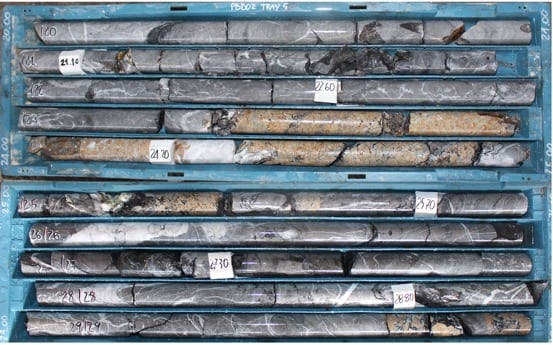Continues To Expand Gorno Mineralisation In Italy
Alta Zinc Limited (ASX: AZI) has observed multiple intersections of high-grade zinc, lead and silver mineralisation in nine drill holes and five channel samples at the Ponente West, Ponente Central and Pian Bracca South areas of the Gorno Mine in Italy.
At the Ponente West area drill results extended the mineralisation a further 180m north and 90m east. More new mineralisation has also been discovered another 260m to the east where channel sampling returned high- grade mineralisation from the Ponente Central area.
Managing Director, Geraint Harris, said that additionally, at Pian Bracca South drilling and channel sampling has extended the mineralisation a distance of 90m north towards the Pian Bracca Central corridor.
“We are very pleased that our multi-area exploration strategy has been successful in extending mineralisation at Pian Bracca and Ponente,” Mr Harris said.
“These results together with those from our last 18 months of successful exploration will support our upcoming Mineral Resource estimate (MRE) and build a platform for future Project development.
“Our drilling has now led us into several new areas to continue expanding the mineralisation footprint outside of and in addition to the upcoming MRE. The aim is to continue to deliver on the significant high- grade mineral growth potential that the Gorno District is providing.”
Geological and structural mapping of Pian Bracca South has shown there is a significant mineral enrichment in a N-S direction that is controlled by several faults lying between Pian Bracca and Pian Bracca South, a distance of over 100m.
Significant mineralisation is clearly visible in many other sidewalls which are currently inaccessible to sample for safety reasons, and these sites will be made accessible and sampled in due course. See Figures 2 and 3.
In Pian Bracca Central, drill hole PBD52 was set-up to cross an untested E-W fault on the southern edge of the corridor, resulting in an unexpected extension of mineralisation to the south.
Ponente West drilling has been stepped out to the north and east. This has resulted in an extension of the mineralisation 180m to the north and 90m to the east of previously reported results, see Figures 1 and 4. There is also the prospect that mineralisation may continue a further 300m to the north where mineralisation was intersected by historical drilling in the Cascine area (Figures 4 to 6). Access to and into Cascine requires some rehabilitation after which the area can be channel sampled and drilled with a campaign of short holes.
New mineralisation has also been discovered another 260m to the east of the Ponente West mineralisation. Channel sampling has returned high-grade mineralisation on the western edge of the Ponente Central area, with significant sulphide mineralisation visible on the sidewalls Channel sampling at two sites in Ponente Central returned the following high-grades of mineralisation:
- 2.0m at 20.7% Zn and 6.2% Pb (26.9% Zn+Pb) and 50g/t Ag; and
- 2.0m at 30.4% Zn and 6.2% Pb (36.6% Zn+Pb) and 38g/t Ag, (CACH02)
Similarly, there is strong evidence that the Ponente mineralisation extends south into an area of historical drilling that returned a number of intersections of high-grade mineralisation. This potential extension will be tested from existing development in the area.
Clearly these extensions to the north, south and east of the current Ponente exploration area represent several tangible and accessible near-term exploration areas which, post MRE update, can be systematically assessed for further Mineral Resource growth potential.
For further information please visit: http://www.altazinc.com/












